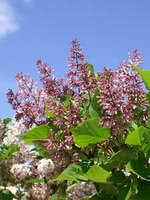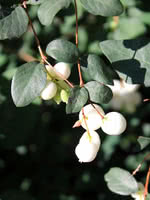Mon-Fri 9am - 5pm Mountain time
Manchurian Lilac (Korean Lilac) vs Western Snowberry
Syringa pubescens ssp. patula
Symphoricarpos occidentalis
NOT AVAILABLE THIS SEASON - MIGHT RETURN
NOT AVAILABLE THIS SEASON - MIGHT RETURN
Manchurian Lilac (aka Korean Lilac) is a medium-sized shrub that features fragrant clusters of pale purple flowers in late spring.
Manchurian Lilac is less affected by disease than other lilacs and will create a beautiful border, hedge, or privacy screen. If you are looking for a lilac for your shelterbelt, consider Common Purple Lilac or Villosa Lilac first.
Like the Common Snowberry, the Western Snowberry is a small shrub with pink flowers useful for feeding livestock and preventing erosion. Unlike the common species, however, the Western Snowberry is much more suited to wet conditions, capable of persevering through poor soil drainage and occasional flooding.
After the Snowberry's flowers have bloomed, it produces berries which often last on the plant through winter. These berries are toxic to humans, but livestock and local wildlife love them! Those hoping to attract wildlife to their property can plant Snowberry and expect to see animals foraging on it much later in the year than other plants.
Manchurian Lilac (Korean Lilac) Quick Facts
Western Snowberry Quick Facts
Toxicity: berries are toxic to humans

